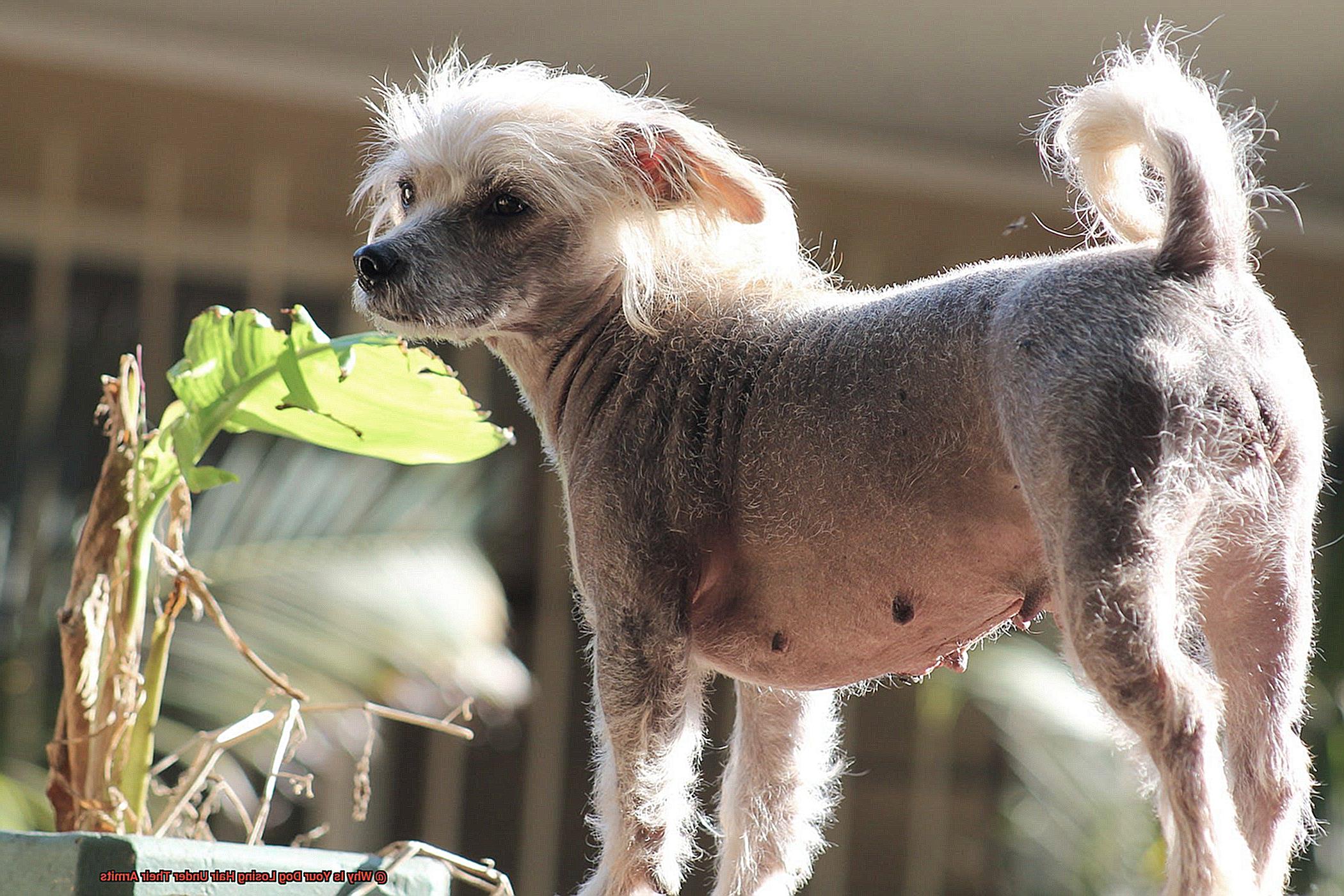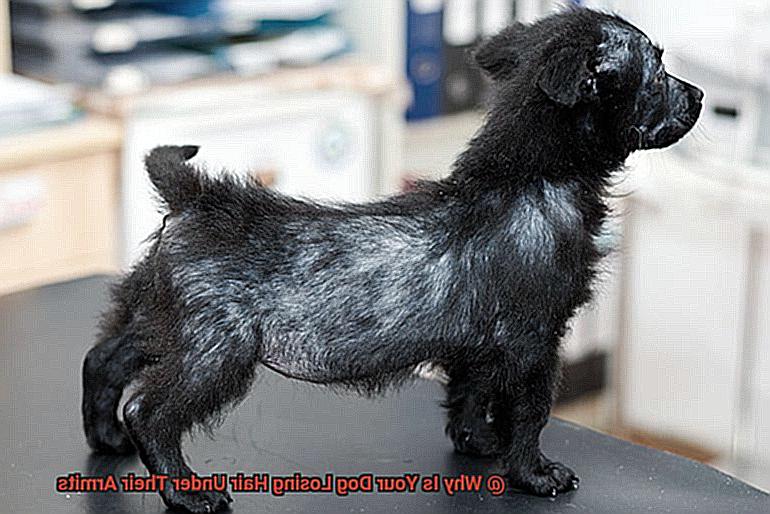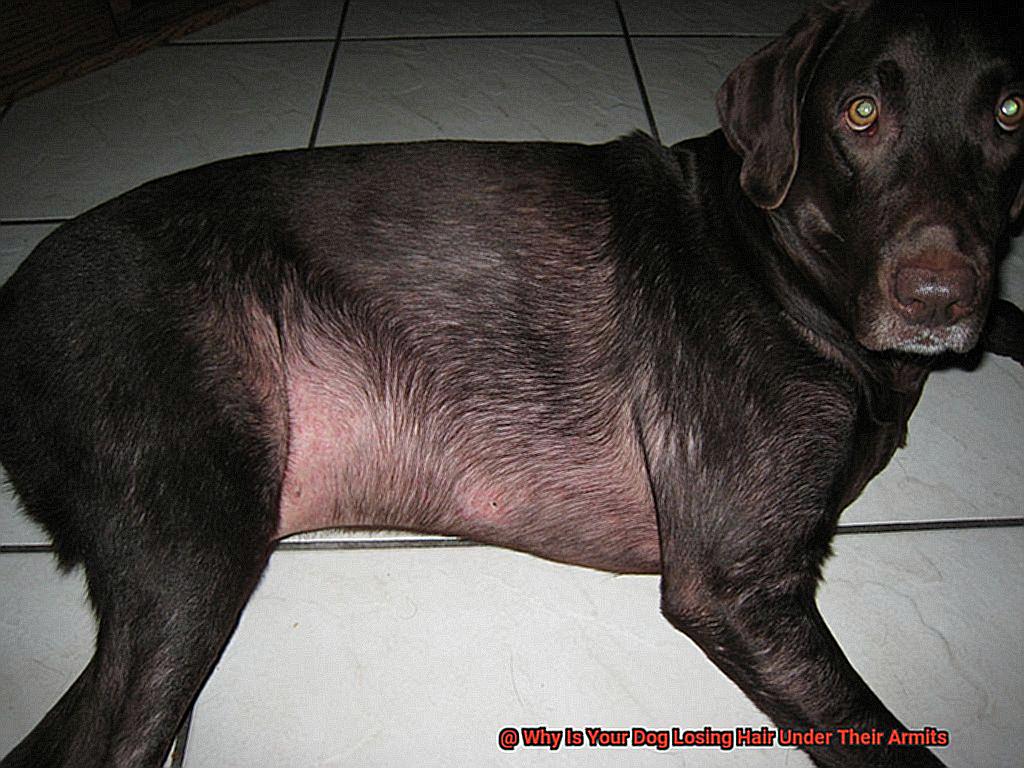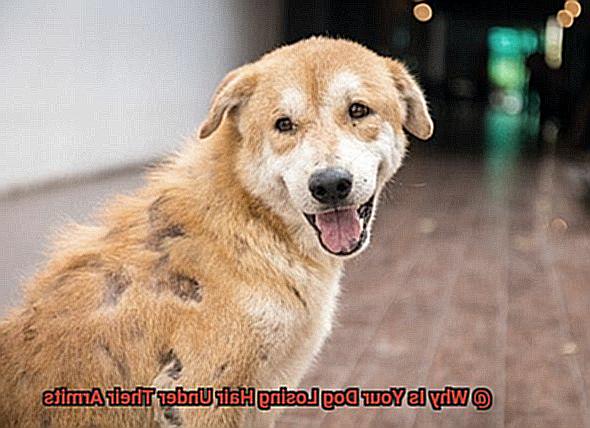Why Is Your Dog Losing Hair Under Their Armits?
Many pet owners have noticed this issue and wondered what could be causing it.
It’s scary to see your pup without fur, but there are usually straightforward explanations for why this is happening.

In this blog post, we’ll discuss the potential reasons behind your dog’s hair loss under their arms and address potential treatments for the disease.

By investigating the causes and treatments of hair loss in this area of a dog’s body, you can help ensure that your puppy stays healthy and happy for years to come.
So, why is your pup losing hair under their armpits? Allergies or skin irritations from fleas, ticks, or other parasites are common causes.
Allergies can cause inflammation that results in excessive scratching and licking in the affected area, resulting in patchy bald patches on the skin.
Poor diet or an underlying medical condition such as hypothyroidism can also lead to hair loss in dogs.
Other potential causes include hormonal imbalances, bacterial or fungal infections; environmental factors such as extreme temperatures; and even psychological problems like stress or anxiety.
In some cases, further tests may need to be performed by a veterinarian to determine what’s causing the disease.
No matter what’s causing your pup’s hair loss under their arms, it’s important that you take action quickly so they don’t suffer any more pain or health issues later on.
Read on for more information about why your dog is losing hair under their armpits and how to help them get back to normal.
Common Causes of Dog Hair Loss Under Armits
Contents
- 1 Common Causes of Dog Hair Loss Under Armits
- 2 Diagnosing the Cause of Hair Loss in Dogs
- 3 Treating Dog Hair Loss Under Armits
- 4 Home Remedies for Dog Hair Loss Under Armits
- 5 Preventing Dog Hair Loss Under Armits
- 6 When to See a Vet for Your Dog’s Bald Spot
- 7 Different Types of Skin Conditions That Can Cause Bald Spots on Dogs
- 8 Other Reasons Why Your Dog May Be Losing Hair Under Their Armpits
- 9 Conclusion
Hormonal imbalances, such as hypothyroidism, can cause your dog to suffer from hair loss in the armpits.
Allergies can also lead to hair loss due to itching and scratching.
Bacterial or fungal infections may also be the culprit of your pup’s missing fur in this area.
Stress can also cause your dog to lose hair in their armpits due to excessive licking and grooming.
Fleas, ticks, and mites can also result in hair loss due to parasite irritation.
If you suspect any of these causes for your dog’s hair loss under their arms, it’s best to speak with a vet for further diagnosis and treatment.
Don’t wait – make sure you get your pup the help they need.
Diagnosing the Cause of Hair Loss in Dogs
If your pup is experiencing hair loss, it can be a worrying issue for any pet parent.
There are many potential causes of this condition, ranging from parasites to allergies.
To better diagnose the cause of your dog’s hair loss, it’s important to first consider their environment and lifestyle.
Common culprits include fleas, ticks, mites, ringworm, mange, allergies and stress.
Additionally, look for any signs of infection such as redness or scabbing on the skin.
Your veterinarian may perform a physical examination and take samples from the affected area to accurately identify the underlying cause.
Blood tests may also be recommended to rule out any systemic diseases that could be causing the hair loss.
Treating Dog Hair Loss Under Armits
If your pup is experiencing hair loss under their armpits, it could be due to a variety of causes.
Allergies, parasites such as fleas and ticks, infections, and skin diseases like mange can all be responsible.
To get to the root of the problem, it’s best to take your pup to the vet for an examination.
Depending on what the underlying cause is, they may need different treatments in order to get their fur back in tip-top shape.
Allergic reactions can be treated with antihistamines or steroids to reduce inflammation and itching.
Parasites are usually treated with topical or oral medications.
Infections require antibiotics or antifungal agents for proper treatment.
Skin diseases like mange may need medicated baths or other treatments prescribed by your veterinarian.
In addition to medical care, regular brushing can help remove any loose hair and prevent further hair loss.
Brushing also keeps your pup’s coat clean and shiny.
Home Remedies for Dog Hair Loss Under Armits
Are you concerned about your pup’s hair loss under their armpits? Don’t worry – there are some easy home remedies that can help get your pup back to looking and feeling their best.
Oatmeal baths are a great way to reduce inflammation and soothe the skin, while coconut oil is an effective natural moisturizer that can nourish the skin and promote healthy hair growth.
Apple cider vinegar is also a popular home remedy, as it can be used as an antifungal and antibacterial to help treat any underlying infection that could be causing the hair loss.
In addition, make sure your pup is getting enough essential fatty acids in their diet to keep their skin and coat healthy.
Finally, keep your pup’s armpits clean and dry at all times to prevent any further irritation or infection that could lead to more hair loss.
Preventing Dog Hair Loss Under Armits
There are a few simple steps you can take to help prevent this from happening.
- First, make sure to groom your pup regularly. Brushing their fur will remove any dead or loose hairs, reducing the amount of hair that falls out.
- Second, check for fleas and ticks. These parasites can cause serious hair loss in dogs, so it’s important to identify them as soon as possible and treat them if necessary.
- Third, keep your dog’s skin healthy by providing them with a good quality diet, plenty of exercise and regular baths with a gentle shampoo.
- Fourth, avoid using harsh chemicals on their fur. Flea treatments or shampoos can irritate your pup’s skin and lead to further hair loss, so make sure to use these products only as directed.
- Finally, monitor the area for any changes. If you notice anything unusual in their fur or skin, contact your veterinarian right away for advice.
When to See a Vet for Your Dog’s Bald Spot
If you’ve noticed a bald spot on your pup, it’s time to pay a visit to the vet.
With their expertise, they’ll be able to diagnose the cause and provide the right treatment.
The most common causes of bald spots in dogs are allergies, mange, fungal infections, and skin cancer.
Allergies and infections can usually be treated with antibiotics or antihistamines.
But if the bald spot is caused by a tumor or cancerous growth, more aggressive treatments may be necessary.
It’s important to take your dog to the vet if they have a large bald spot so that you can get an accurate diagnosis and begin treatment as soon as possible.
Different Types of Skin Conditions That Can Cause Bald Spots on Dogs
If you’ve noticed bald spots on your beloved pup, it could be due to a skin disorder.
Here are five of the most common skin conditions that can cause bald spots on dogs.
Allergies can bring about intense itching in dogs, which can lead to hair loss in their armpit area.
Parasites and fleas can also be the culprits behind hair loss in this region.
Skin infections caused by poor hygiene or contact with contaminated objects or surfaces can also cause hair loss in your pup’s armpit area.

Hormonal imbalances, such as hypothyroidism, can also result in bald spots on your dog’s head and other areas of its body.
Stress is another potential cause of bald spots on your pup if they are exposed to changes in their environment or routine that they are not used to.
If you find any bald spots on your pup, it’s best to take them to the vet for a check-up so they can determine the root cause and provide the appropriate treatment plan for your furry friend.
Other Reasons Why Your Dog May Be Losing Hair Under Their Armpits
If your pup is losing hair in their armpits, it could be a sign of something more serious.
Hair loss in this area can be caused by numerous other reasons that can be concerning.
Allergies, parasites, infections, and even hormonal imbalances may all lead to your dog losing fur under their arms.
Allergies can cause your pup to scratch or lick the area excessively, resulting in hair loss.
Parasites such as fleas and ticks can also cause irritation and inflammation in the armpit area which leads to thinning fur.
Skin infections like mange or ringworm can also lead to hair loss around the armpits.
Hormonal imbalances such as hypothyroidism may also cause hair loss in this region.
Stress or anxiety can also contribute to excessive scratching which could result in bald patches in the armpit area.
If you notice any areas of hair loss on your pup, it’s important to pay attention and seek medical help right away.
A vet will be able to properly diagnose the issue and provide a treatment strategy for your furry friend.
Conclusion
No pet parent wants to see their dog suffer from hair loss in the armpit area, but it could be a warning sign of something more serious.
To get to the bottom of the issue, it’s essential to bring your pup to the vet for an examination.
Depending on what they find, they may need different treatments to get their fur back in tip-top shape.
At home, you can help your pooch’s coat by bathing them with oatmeal or coconut oil and adding essential fatty acids to their diet.
Regular brushing will also keep their coat clean and shiny, while removing any loose hairs from its surface.
Additionally, make sure your dog is free of fleas, ticks, and mites since these parasites can cause significant hair loss.
Lastly, monitor your dog’s skin for any changes and consult a specialist if you find anything unusual.




